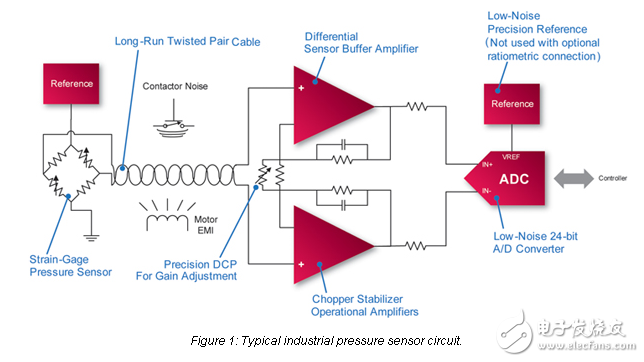
资料下载

工业测量中的精度挑战
工业测量中的精度挑战
肮脏、嘈杂、杂乱的工业工厂环境似乎是人们期望找到高科技的最后地方。平凡的功能,如压力、温度、流量和在现代工厂的环境包括水、石油、油漆、果汁、面包面团中材料的无限多样,或钢铁需求不断增加为了更准确改善成本和效率的要求在一个非常具有挑战性的环境–测量准确度惊人的水平,并减少对环境的影响。
首先,考虑到许多传感器技术由于其自身的物理特性和由于周围环境的影响而导致的整体测量精度不到0.1%。热电偶传感器非线性负载细胞蠕变,应变计的零点漂移,和其他误差源都总计达降解在偏移的测量对。
同时,观察到大多数流行的传感器技术提供了在输出电压输出(只有分数在10 V或更少的励磁电压热电偶或应变计的MV,和数万)体积小(响应时间快,体积小,和最小的对被测介质的影响)在非常高的阻抗结果(零电流),或高灵敏度由于偏置电流通过传感器误差补偿。

Finally, observe that in most cases the physical arrangement of the process itself imposes numerous challenges, including long cable lengths which incur electrical interference, difficult packaging due to the environment involved, and of course the aforementioned dirty, noisy mess of a factory floor filled with motors, solenoids, contactors, AC heaters, and so on.
If we desire to preserve the accuracy of our sensor in this environment, we must take into account the influence of a wide variety of error-producing factors. They include the operating temperature range, which is in the range of 100°C and, therefore, requires careful temperature compensation. Offset errors, due to bias currents causing voltage drops across connectors and long lead lengths (including thermoelectric effects at bimetal interfaces) and induced noise is addressed by utilizing techniques such as two-wire, differential sensing, and ratiometric circuit configurations which take advantage of the CMRR (Common-Mode error Rejection Ratio) of a carefully-designed measurement circuit. Supply variations must also be considered, demanding a circuit designed to provide a high PSRR (Power Supply error Rejection Ratio).
声明:本文内容及配图由入驻作者撰写或者入驻合作网站授权转载。文章观点仅代表作者本人,不代表电子发烧友网立场。文章及其配图仅供工程师学习之用,如有内容侵权或者其他违规问题,请联系本站处理。 举报投诉
- 相关下载
- 相关文章





